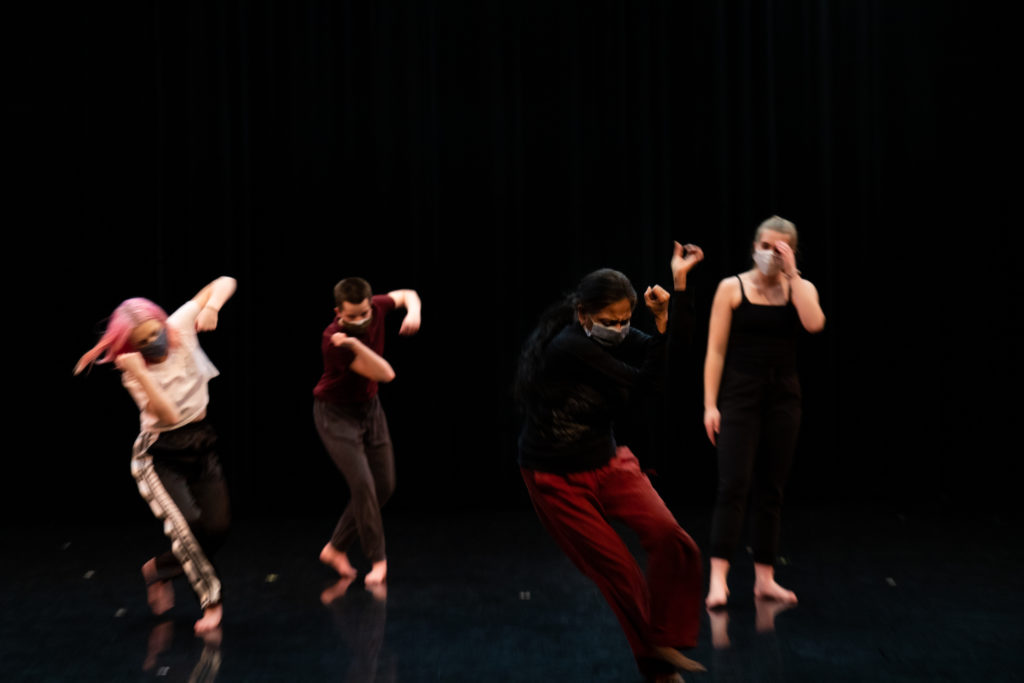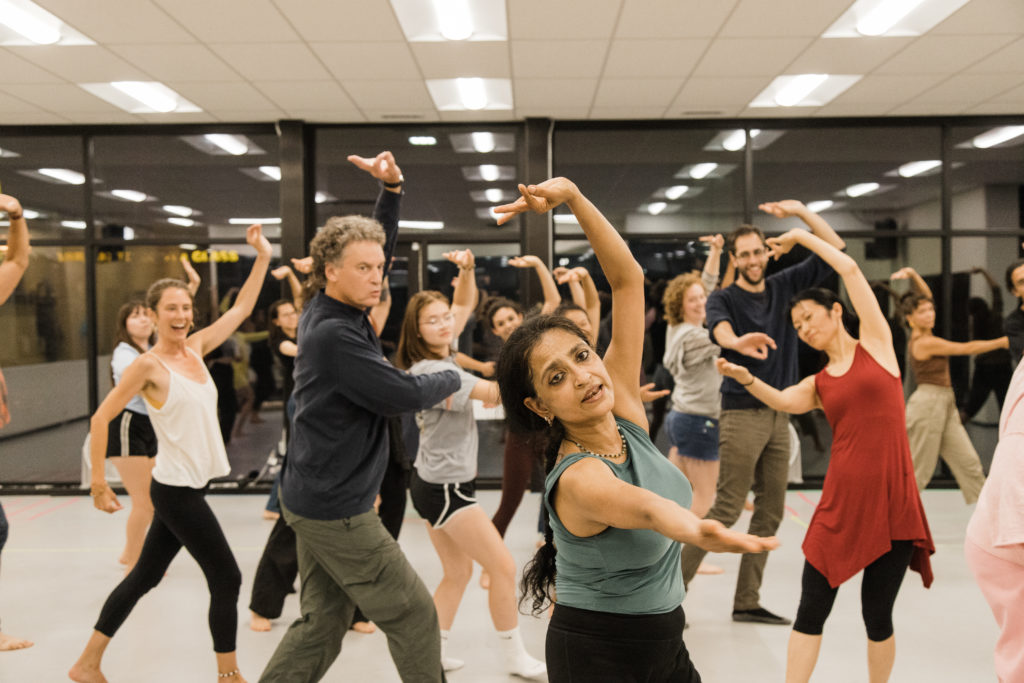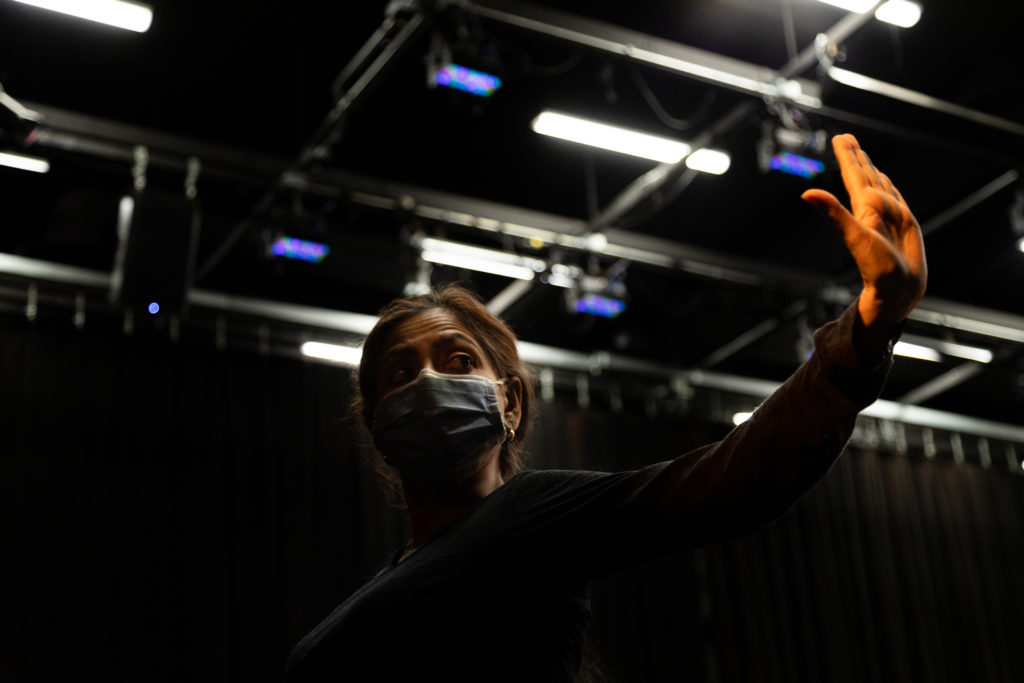
Earlier this year, choreographer and University of Minnesota–Twin Cities professor Ananya Chatterjea took a group of students to a Native water-protection center in Palisade, Minnesota, where her company, Ananya Dance Theatre, was performing.
In the piece, a section of her 2017 work Shyamali: Sprouting Words called “Shields,” artists moved with handheld shields coated in silver, inspired by the shields created by Native artist Cannupa Hanska Luger, which were used by Standing Rock water protectors to reflect the actions of riot policemen back onto them.
This kind of experiential learning is typical of Chatterjea’s Choreographing Social Justice course, which each year is structured around a different tenet of activism, pushing her students towards their own fiery engagement with the world. Like her choreography, Chatterjea’s teaching—whether in the collegiate setting or with her Ananya Dance Theatre’s Institute for Performance and Social Justice, through her scholarship or her innovative Yorchhā technique—is driven by “her fierceness and her directness and, in a sense, unshakable belief in her moral center that she then communicates to her students,” says her mentor and teacher, Brenda Dixon Gottschild.

Originally from Kolkata, West Bengal, India, Chatterjea’s emergence as a choreographer was rooted in making dances connected to the impacts of gender in Indian women’s everyday lives, like in her early work Unable to Remember Roop Kanwar, which dealt with a South Asian woman’s alleged “suicide” on her spouse’s funeral pyre. “She already had that social justice wheel turning in her work at the beginning,” says Dixon Gottschild.
Since 1998, Chatterjea has been bringing this social justice lens to her classes at the University of Minnesota, where she teaches dance history, theory and movement courses to dance majors. For the past five years, she’s been developing her Choreographing Social Justice (CSJ) course, which in the past has focused on the Black Lives Matter movement, and this year looked at Native people’s call to Stop Line 3, a pipeline whose expansion is designed to carry millions of barrels of tar sands oil over the course of sacred wild rice watersheds, more than 800 wetlands and over 200 bodies of water in Minnesota.

Her CSJ students have the opportunity to learn from her many years of building alliances with Native, Black and other community leaders of color through Ananya Dance Theatre, which she founded in 2004 as a company of Black and brown women and femmes to shape choreographies about global stories of social justice. Her 2013 choreographic work, Mohona: Estuaries of Desire, for instance, emerged in the months after the company had joined Sharon Day, Ojibwe peace activist, for a portion of her 1,200-mile Mississippi River Walk from Lake Itasca to the Gulf of Mexico. In Mohona, Chatterjea demonstrates her commitment to Native water protection by putting her own body on the line: She performed in a life-size bubble onstage, eventually taking on a difficult yogic posture by balancing her entire body on her head and forearms.Her 2017 “Shields” was inspired by the company’s journey to Standing Rock in 2016, where Chatterjea led artists through a dance offering to support Janice Bad Moccasin, a Dakota water protector, healer and close friend.
Chatterjea’s expansive commitment to social justice moves between choreographic work and teaching, as evidenced by her required course for dance majors, Theorizing Dancing Bodies. In it, she broadens the scope of dance studies to include “intersectionality” in dance and performance; she traces the term to the Combahee River Collective’s historic gatherings of Black women activists in the 1970s to examine the interlocking oppressions of race, gender and sexuality. In one class, she presents students with two case studies: One video of a professional couple of white ice skaters who perform their depiction of “Bollywood” dance, and one of another skating couple pretending to be “Natives.” She explains how these performances, “appearing to be inclusive but having not dismantled central consolidations of power” lose sight of the interconnected matrix of social categories located in the body: “Various constructed categories interact on multiple levels to manifest themselves as inequity in society. We wear privilege naturally. You have to be aware of this as art-makers.” These very conflicts, as well as her own struggles in the world of contemporary dance, led her to write Heat and Alterity in Contemporary Dance: South-South Choreographies, her 2020 book framing whiteness as holding a privileged location in contemporary dance “without ever having to mark its own cultural lineage.” (Chatterjea’s first book Butting Out focused on the choreographic works of Jawole Willa Jo Zollar and Chandralekha.)

Since the vast majority of her students come to college steeped in Western dance forms, Chatterjea has the challenge of “reminding them that at some point there is a correct way to move within one aesthetic, but they may not be correct in another,” she says. “Very often they come with a sense, which they have been taught, that that is the only way and that there is a correct way to understand inhabiting the body. I have to remind them that something may look like something they do, but in fact the initiation is different, the embodiment is different, and in fact it has a very different feeling. To notice the subtle ways in which things are different takes a lot of training. I am really inviting them to understand nuance and not take shortcuts.” Or, as Sharon Bridgforth, Chatterjea’s dramaturgical collaborator, describes her teaching: “She expands what is possible for everyone in the room.”
Chatterjea also brings these ideas into the studio in her University of Minnesota contemporary class, where she teaches Yorchhā, her technique that intersects Odissi dance, vinyasa yoga and Chhau martial arts. When teaching Yorchhā’s flat-back series, she guides students to fold forward directly from the hips as they grab hold of their pointer finger, suchi, and fist, mushti, overhead, while bringing the torso down to touch the front of their legs. She shapes a light-hearted environment amidst the difficulties of Yorchhā, as she calls attention to the areas of the form that are “not traditional” because she “made them up.” Sequences such as a spinal twist that moves dancers through parallel legs while twisting the spine and extending the hip are part of the contemporary innovations that she has established.

But even as she inserts these humorous moments in her classroom, she stands by her larger purpose: getting students to engage in “the sustained inhale and exhale,” she says. “I feel that preparation has been the work of training in ADT, and I think it is something that goes against the grain of contemporary times. This notion of going with what is the path of least resistance sometimes leads to shorter spans of shorter breath. What we are in need of today is also these deep, long, held notes over many years. The same note over many, many years. And that I want to uphold. And I think that has been my life’s work.”




